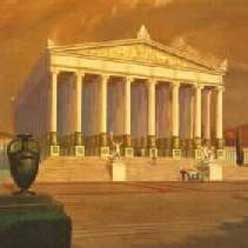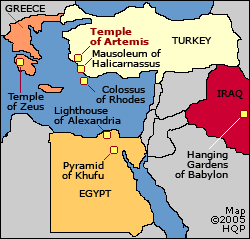Temple of Artemis
 Why the
Temple of Artemis
Seven Wonder
is special
Why the
Temple of Artemis
Seven Wonder
is specialThe Temple of Artemis at Ephesus (Turkey) was one of the most elegant buildings of ancient times.
Temple of Artemis literally has its ups and downs
Up
This Seven Wonder was erected around 600 BC and burned down in about 550 BC. It was then rebuilt into a bigger and more magnificent version.
Down
The Temple of Artemis was destroyed again in 336 BC, this time by an arsonist named Herostratus who wanted to immortalize his name (2300 years later it appears he succeeded).
Up again
The temple was again rebuilt, even bigger and better than before. Except for its lumber-supported roof covered with glazed terra cotta tiles, the new Temple of Artemis was made almost exclusively of marble (a first in its day). Inside, the temple was richly decorated with sculptures and other artworks created by leading artists.
Down again
It more or less survived intact until the invading Goths severely damaged it in 262 AD. What remained of this Seven Wonder slowly disintegrated with the help of earthquakes. By the 5th Century AD, most of the marble had been salvaged for local building needs.
Current state
When I explored the Temple of Artemis site 15 centuries later, all that remained was one reconstructed column (of uncertain origin) and a marshy field strewn with large chunks of marble (that may or may not have belonged to the Temple of Artemis).
More Temple of Artemis tips & insights
Columns
The edifice boasted over 100 graceful marble columns, each measuring more than 15 meters (50 feet) in height
Area
The structure covered an area several times larger than does the Acropolis in Athens.
Alexander the Great
Many tales about the Temple of Artemis have been passed down by ancient writers.
One was penned by the Roman historian Pliny. He related that Alexander the Great offered to finish rebuilding the burned down temple on the condition that his name be inscribed in gratitude on the new Temple of Artemis.
These temple authorities were miffed by this egotistical demand of an outsider, but didn't want to anger the powerful conqueror Alexander. So, they came up with this clever diplomatic rejection: It is unfitting for one god to build a temple for another god.
Another Alexander legend
He was born on July 21, 336 BC, the same day the earlier mentioned arsonist Herostratus burned down the Temple of Artemis. The goddess Artemis did nothing to stop the temple from burning because she was too busy attending to Alexander's birth.
BC tourism
The Temple of Artemis was a tourist attraction in its heyday. It drew travelers from afar. A local cottage industry produced souvenirs and religious items including miniature statues of Artemis. Hawkers sold them to visitors, which helped the local economy.
Ephesus
If you're going to visit the Temple of Artemis site, be sure to reserve a day or two to explore the spectacular ruins of Ephesus. It is a Hillman Wonders Silver Medal winner. Click the "top 1000 wonders" link below to see my complete list of my Gold, Silver and Bronze Medal winners.
Temple of Artemis map location



